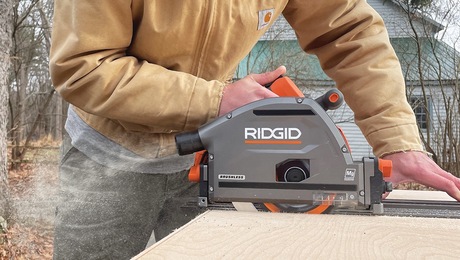I have an existing attic space that is being turned into a second floor area. The existing rafters are 2X6 @ 16″ o/c and have a 8/12 pitch. I am placing the exterior knee wall (48″ high) at the perimeter of the space approx. 7′-6″ in from the exterior first floor wall. I have to insulate the space and considering a spray-foam insulation such as “Icynene” or a polyurethane foam because I only have 5-1/2″ of space within the rafters. Now on to my question: Should I insulate the ceiling from the bottom of the rafters all the way up to the new flat ceiling or should I insulate only the sloped ceiling within the room and then insulate the knee wall and floor joists outside the knee wall? I am thinking that it makes more sense to keep the area behind the knee wall warm and just insulate beteen the rafters. Any suggestions?
Discussion Forum
Discussion Forum
Up Next
Video Shorts
Featured Story

The best tool for straight, splinter-free cuts is made even better without a cord.
Featured Video
Builder’s Advocate: An Interview With ViewrailHighlights
"I have learned so much thanks to the searchable articles on the FHB website. I can confidently say that I expect to be a life-long subscriber." - M.K.

















Replies
It's usually best practise to consider the knee wall as an exterior wall and insulate accordingly. Your main problem is going to be proper ventilation from the area behind the knee wall to the new attic area, this is critical, especially in colder climates. I've seen ice damming of over a foot when air flow has been reduced in this area. If you are planning on using spray-in foam how are you planning to vent the air behind the knee wall into the attic space.
That is a good question. I forgot that the attic will now be cut off from the eave ventilation. Can I use standard polystyrene baffles in each rafter bay between the knee wall space and the attic space or will the foam insualation compress them and cut off the air flow? I guess plywood baffles could be formed in each bay and then sprayed to allow air flow above but I will lose some of the very little space that I have for insulation. I may have to strap the underside of the rafters to give me some more space for insualtion. Any comments?
Code, custom or resale values dictate 60 inch knee walls, I think. Some of the Breaktime Gurus will know better. On the last attic upfit, we furred the 2*6's with 2*6's. Then we added nine inch insulation. Ours is a Southern climate, yours is different? Furring and collar ties gave us plenty of room for Baffles and insulation. Somebody here will surely speak up if i'm wrong. Old Pro
If it was me, I'd use chicken wire behind the knee wall and R-20 friction fit fibreglass in the walls and R-40 in the ceiling. For the sloped ceiling I'd use 2 layers of R-10 styrofoam sm (4 inches).
If that's not enough for you, you could try" Low-E Insulation " made by ESP, Inc. out of New Oxford, PA.. It comes in a roll 1/4' x 4' x 125' (looks like bubble wrap with aluminum foil on both sides), the manufacturer claims it takes the place of a vapor barrier when the seems are taped and will add an R value of 7.53 to your ceiling and 7.78 to the walls.
PS. Check your local codes before using either the SM or the Low-E.
Your on the right track.
Use the sprayed polyurethane the whole lenght of the 2x6 rafter and don't bother with trying to isolate the kneewall and flat portion of the ceiling from the room. Otherwise you will have several lines around the entire perimeter of your space that will invite breaching of the envelope.
Make sure that you start from the outside wall plane so that the foam covers the exterior wall plates entirely and all the way to the ridge of the roof.
Don't worry about ventilation, in practice, you don't need it if you insulate/seal the outside plane of the envelope.
Keep it simple with one product along one plane of the envelope and you will have a better seal that will be continuous instead of intermitent.
Gabe